The ‘slashing parson’ of ’98
Published in Features, Issue 1 (January/February 2014), Volume 22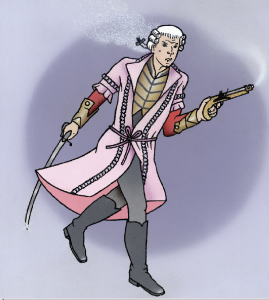
Revd Robert Rochfort, the ‘slashing parson’ of ’98, by Robert Ballagh (after Eimear Phelan).
Outside of Wexford, Carlow was one of the biggest centres of rebel activity in Leinster in 1798, and tales of the rebellion and its suppression at a local level are still emerging. The story of Revd Robert Rochfort (1775–1811) of Clogrennane, Co. Carlow, is a case in point. An investigation into his life and early death is dominated by allegations of cruelty and sectarian butchery in June of 1798, and the unlawful execution of supposed United Irishmen. He cuts an intriguing figure in his fusion of military and religious concerns, striking in his clerical garb, Bible in one hand and cat-o’-nine-tails in the other, unapologetic to the last in his preaching of a dominant Protestant Ascendancy. Interesting as a case-study of Orange sectarianism, his story also hints at the persistence of anti-Protestant sentiment in the folk memory of Carlow in the decades that followed. Thirty years after the rebellion, Rochfort was demonised and styled the ‘slashing parson’ in the local liberal press. His premature death at the age of 36 locked him into a legend he could never change, and his reputation hovered like a spectre over his family for decades, destroying their electoral chances and their entitlement to a good name until their final departure from Carlow in 1923.
Carlow in ’98
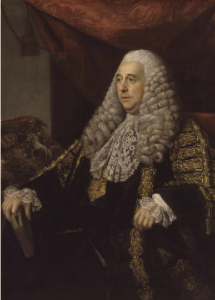
Lord Lieutenant Camden—in 1796 he provided an independent living for Rochfort in the church. (National Portrait Gallery, London)
The sectarian savagery of the rebellion in Carlow is all the more striking when one considers the claim in United Irishman William Farrell’s memoir that in the 1780s ‘there was no part of Ireland where a better feeling of friendship existed between both Catholics and Protestants’. By 1797 it was estimated that there were 400 ‘rebels’ in the vicinity of Leighlinbridge, just six miles from Clogrennane Lodge. Alarmed by raids for arms on the homes of gentlemen in their immediate neighbourhood, Robert and his brother John Staunton Rochfort established a local yeomanry unit comprising infantry and a cavalry corps, headed by Captain Robert Rochfort. He proved far more zealous and impetuous in his actions than his older brother. The difference in their ages may have been a factor: John Staunton was 33 at the time of the rebellion, while Robert was 22. While the former wrote alarmist and pleading letters to officials in Dublin Castle, Robert was wont to take matters into his own hands. Riding at the head of his unit, his patrols were so dreaded as to merit mention in Sir Richard Musgrave’s famous Memoirs of the Irish Rebellion of 1798 (1802). The attempted shooting of one of his yeomen and Robert’s subsequent discovery of a United Irishman in his own ranks increased fear and paranoia, and the demesne of Clogrennane Lodge came to resemble a battle site where only one side had taken the field. The Rochforts utilised their yeomanry as a private defence force, and a section of the Ninth Dragoons from Carlow town was also regularly assigned to guard duty at Clogrennane. They became a lot more self-assured, however, because of their involvement in the greatest threat to United Irish activity in the county: the Orange Order.
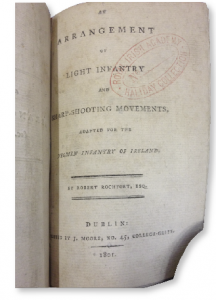
Title-page of Robert Rochfort’s 1801 pamphlet on yeomanry manoeuvres. In this short tactical handbook he lamented ‘observing the gradual decline of that esprit du guerre which at one time so eminently distinguished the Yeomanry infantry of Ireland’.
The Rochforts’ involvement in the Orange Order and their leading role in its propagation in Carlow brought them their greatest notoriety in the story of the 1798 rebellion. It left a notable and vicious sectarianism in its wake and inspired Robert Rochfort in much of the savage violence he perpetrated that summer. As Maura Duggan has argued, the arrival of the Orange factor into Carlow’s volatile crucible provoked the disgruntled elements of society into open rebellion from fear of apparently imminent Orange brutality. The Rochforts were intimately involved in the earliest creation of Orange Grand Lodges at county level from 1797, and Robert Rochfort soon became Grand Master of Carlow. Recruiting from his largely Protestant yeomanry corps, he would surely have been an unforgiving recruiting agent. John Staunton Rochfort later conceded that their yeomanry was essentially a Protestant institution and that ‘I think they [the yeomanry] have always been afraid of the Catholics’.
Sectarianism was at the very heart of the Rochfort agenda, as both ingredient and by-product. They embraced the potential of the Orange Order as a militant Protestant force to counteract the growing strength of the United Irishmen, which they believed was an essentially Catholic conspiracy. The Order provided them with a much-needed sense of security, and they gladly played upon the common fear of Orange violence, to the extent that the under-secretary in Dublin Castle, William Elliot, lamented to his superior Thomas Pelham in early June that ‘a strong religious spirit’ as ‘mischievously’ promoted by Col. Rochfort and the Orange association in Carlow had become a marked feature of the rebellion.
In a very short space of time, Orangeism, Protestantism and oppression became synonymous concepts in the minds of the Catholic population. As a clergyman, the Orange Order was the perfect vehicle for Robert in its merging of political, military and religious agendas. While a later acquaintance, the diarist Elizabeth Ham, was struck that ‘he held the seemingly anomalous professions of captain of a troop of Yeomanry, and clergyman’, for Rochfort the two roles shared the same objective and were in many ways one and the same thing. There is even evidence to suggest that he preferred his military title to his clerical one. In Carlow in 1798 he not only personified but legitimised Catholic fears of the Orange spectre.

Belt plate of his Carlow yeomanry infantry. (Royal Irish Academy; James Adams and Sons)
With such fears whipping the demoralised United Irishmen into a frenzy, they launched an ill-fated attack on Carlow town on the night of 23 May 1798, where 630 people were said to have been killed. The Rochforts played no part in the affairs of that night but were central in the weeks after the battle to the prosecution of rebel suspects in Leighlinbridge, where John Staunton Rochfort, as the local magistrate, set up his headquarters. Robert’s stay in the village was to make him infamous. Most of the allegations against him at this time are contained in a sensational mock-obituary by the indomitable Watty Cox in his Irish Magazine in 1811, where Rochfort was granted by far the lengthiest death notice of several demons of ’98. Portrayed as rabid and vengeful, he is said to have personally used a taws and a sword on prisoners, and clapped his hands in time ‘to the music of the triangles’ as prisoners were tortured. A pitiable sectarianism is construed in the claim that he held a Bible in his hands during many of these activities. While such violent excesses were certainly possible given Robert’s sense of righteousness, damning evidence can be found outside Cox’s diatribe, most notably in an account by David ‘Hibernicus’ Byrne, in whose mother-in-law’s house Rochfort had accommodated himself.
Friendless post-rebellion
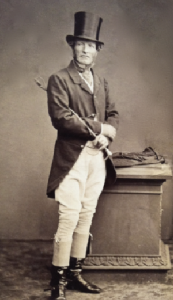
Horace Rochfort (1807–91), nephew of Revd Robert Rochfort, failed to get elected for County Carlow on a reform ticket in 1830. His uncle’s reputation hovered like a spectre over the family for decades, destroying their electoral chances and their good name until their final departure from Carlow in 1923. (Turtle Bunbury)
In the years after the rebellion, Robert’s expectations for reward in a newly loyal nation were to be sorely disappointed. The glory of the summer of 1798, as he saw it, was to be the highlight of his life’s experiences in terms of drama, excitement and personal satisfaction. Post-rebellion Carlow remained deferential to its Protestant rulers, with Edward Wakefield (who interviewed Robert while researching his Account of Ireland) observing that the Carlow gentry were largely ‘ignorant and conceited’ and prone to unwarranted and inexcusable violence towards their social inferiors. Robert certainly clung to militarism, and in writing a short tactical handbook for use by the Irish yeomanry in 1801 he lamented ‘observing the gradual decline of that esprit du guerre which at one time so eminently distinguished the Yeomanry infantry of Ireland […] I hope I shall see that their loyalty, like the Phoenix rising from the ashes, will shew itself in greater splendour than before’. It seems, however, that the controversy attached to his military activities proved counter-productive to his elevation. Petitions by his extended family to many notables (including Chief Secretary Arthur Wellington) proved fruitless and Robert failed to find a parish. In direct contrast, John Staunton Rochfort (who mellowed significantly with time and age) enjoyed a blossoming public career. Had tales of Robert’s violence grown wings and flown to the authorities, eager to hush rumours of military excess? Rochfort’s friendlessness at this point can in all probability be read as a tacit admission by his acquaintances, relatives and colleagues that he had gone too far in the summer of 1798, that his stock had been damaged, and that they could not or would not risk tainting themselves by association with him.
Apocalyptic death
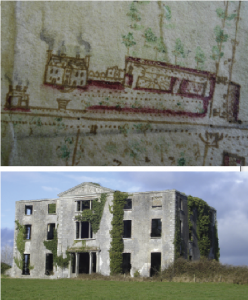
Detail of Clogrennane Lodge, Co. Carlow, home of Robert Rochfort, from ‘A Survey and plan of the Demesne of Clogrennane situate in the Queen’s county and county of Carlow, the estate of John Rochfort, 1774’ by Tomas Ivers, and (below) the ruins of its successor, Clogrennane House, built by his brother, John Staunton Rochfort, c. 1815 and abandoned by the family in 1923. (National Library of Ireland)
In early 1811 Robert manifested signs of a corruptive and mysterious disease, and the end came on 30 June at Clogrennane Lodge at the age of 36. His place of burial is uncertain, but it was probably in the family plot in St Audoen’s Church in Dublin. It was a sudden, painful and unexpected end, typical of the disappointment and frustration of his later years. As the news spread, local people saw the hand of vengeance in his demise, with a smack of divine retribution. Stories circulated of a plague of parasites on Rochfort’s body, which allowed those victimised by the reverend some satisfaction. In Byrne’s version, Rochfort had died with ‘the vermin swarming on every part of his body in such numbers, that a servant with a brush, could not in appearance diminish their quantity, though constantly employed in brushing them off’. Watty Cox added, in apocalyptic fashion, that vengeful locals approached the windows of Clogrennane Lodge to sneer at Rochfort’s misery inside, being forcibly driven away by a faithful servant.
In death, he became the focus of anti-Protestant sentiment in the county. By 1825 John Staunton Rochfort was trying to distance himself from what he called ‘an Orange feeling’, advocating new, more liberal and paternal politics, but his charitable works and efforts to promote industry and agriculture were always threatened by Robert’s shadow. When his enlightened and liberal son, Horace Rochfort (1808–91), stood for the county on a reform ticket in 1830, he suffered by his nominal association with his uncle and failed in the attempt. Although it was 30 years after the rebellion, the Carlow Morning Post highlighted his link with the ‘slashing parson’ and many voters voiced their inability to reconcile their abhorrence of the reverend with support for his promising nephew. Even in 1865, despite his celebrated efforts for relief in the county during the Famine, Horace Rochfort’s second and last appeal to the electorate was drowned out in Carlow courthouse by his opponents chanting ‘’98’.
Perhaps, then, the crux of Robert Rochfort’s story is his legacy. While he is worthy of notice as an embodiment of overtly aggressive Orangeism, his real significance probably lies in the power his sectarian reputation had to negate much of the subsequent good work of an otherwise popular landowning family. For many Carlow people, and for generations to come, forgiving the Rochforts by voting for one of them became an inherited impossibility. As one Carlow farmer was quoted as saying in 1832, ‘Vote for him! By gar, dat would be de same as to eat de fryin-pan and lave de meat.’ HI
Shay Kinsella is a Ph.D candidate at St Patrick’s College, Drumcondra.
Read More : Murder before breakfast
Background
Further reading
D. Byrne, Hibernicus, or Memoirs of an Irishman, now in America (Pittsburgh, 1828).
M. Duggan, ‘United Irishmen, Orangemen and the 1798 rebellion in County Carlow’, in T. McGrath (ed.), Carlow: history and society (Dublin, 2008), 535–86.
W. Farrell, Carlow in ’98 (ed. R. McHugh) (Dublin, 1949).
L. Swords (ed.), Protestant, Catholic and Dissenter: the clergy and 1798 (Dublin, 1997).


















